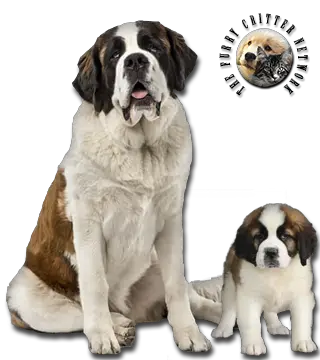Breed Standard
Head: Powerful and imposing. Broad, slightly domed skull. Straight nose bridge. Short muzzle. Large nose.
Ears: Medium size, set on high, triangular, drop.
Eyes: Fairly large. Dark brown color. Dark rims.
Body: Imposing. Powerful neck. Withers strongly pronounced. Ribs well sprung.
Tail: Long, heavy, hanging down and reaching the hocks.
Hair: Two varieties: - Short-haired: Dense, tough, lying smooth; abundant undercoat. - Long-haired: Straight. Culottes, feathering, bushy tail. Short on the face and ears. Abundant undercoat.
Coat: White with moderately large reddish-brown markings. Reddish-brown brindle is permissible. Dark shadings on the head are favored.
Size: Dog: at least 70 cm Bitch: at least 65 cm
Weight: 55 to 100 kg.
History
The Saint Bernard is thought to be descended from ancient Molosser dogs that crossed the Alps with the Roman legions. This breed's roots can be traced to Switzerland where monks at the Grand Saint Bernard Hospice (founded in the Middle Ages) developed the breed around the twelfth century. The St. Bernard quickly developed a reputation as a mountain rescue dog. The most famous Saint Bernard in history, Barry, born in 1800, saved forty people over a period of ten years. Prior to 1830, Saint Bernards had short coats. They were later crossed with the Newfoundland, and the long-haired variety was created. It is the long-haired variety that is now most common. Called at different times in history the Mountain Dog, the Saint Bernard, and the Barry Dog, this breed was officially recognized as the Saint Bernard in 1880. The Swiss Saint Bernard club was formed in Basel in 1884, and the St. Bernard's standard was fixed in Bern as of 1887.
Behavior
Known as a classic example of a gentle giant, the Saint Bernard is calm, patient and sweet with adults, and especially children. However St. Bernards, like all very large dogs, must be well socialized with people and other dogs in order to prevent fearfulness and any possible aggression or territoriality. The biggest threat to small children is being accidentally knocked over by this breed's larger size. Overall they are a gentle, loyal and affectionate breed, and if socialized are very friendly. Because of its large adult size, it is essential that proper training and socialization begin while the St. Bernard is still a puppy, so as to avoid the difficulties that normally accompany training large dogs. An unruly St. Bernard may present problems for even a strong adult, so control needs to be asserted from the beginning of the dog's training. While generally not instinctively protective, a St. Bernard may bark at strangers, and their size makes them good deterrents against possible intruders.
This breed requires considerable space and long walks every day. Energetic daily brushing is required. The St. Bernard does not tolerate heat well.
The St. Bernard was bred to be a working companion and to this day the St. Bernard lives to please its master and is an amiable yet hard worker. St. Bernards have retained their natural ability for scent work and depending on the skill of the trainer and the talents of the dog, St. Bernards can participate in tracking events or even become involved in search and rescue work.
Function
Guard Dog, Mountain Rescue Dog, Pet.
Health
The very fast growth rate and the weight of a St. Bernard can lead to very serious deterioration of the bones if the dog does not get proper food and exercise. Many dogs are genetically affected by hip dysplasia or elbow dysplasia. Osteosarcoma (bone cancer) has been shown to be hereditary in the breed. They are susceptible to eye disorders called entropion and ectropion, in which the eyelid turns in or out. The breed standard indicates that this is a major fault. The breed is also susceptible to epilepsy and seizures, a heart disease called dilated cardiomyopathy, and eczema.






